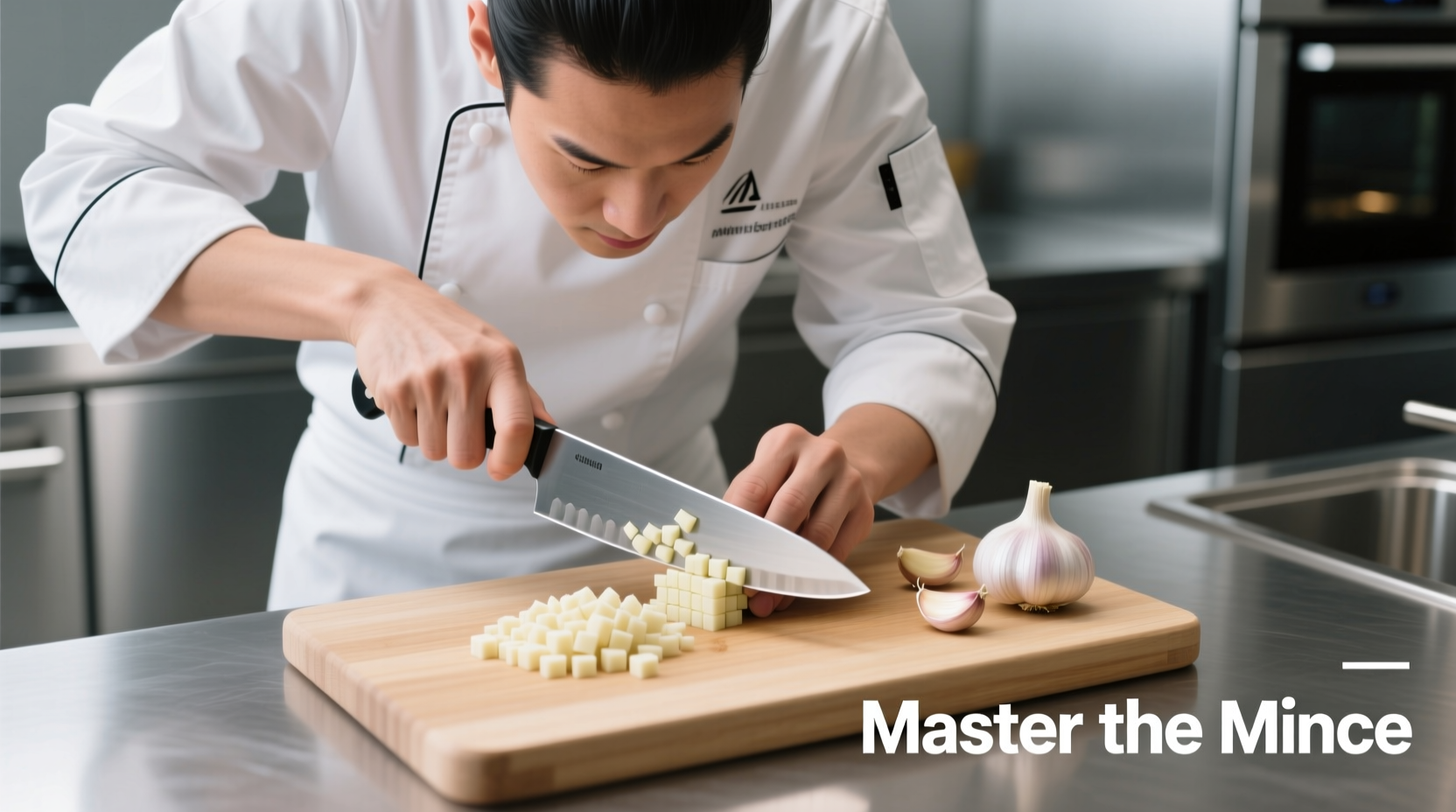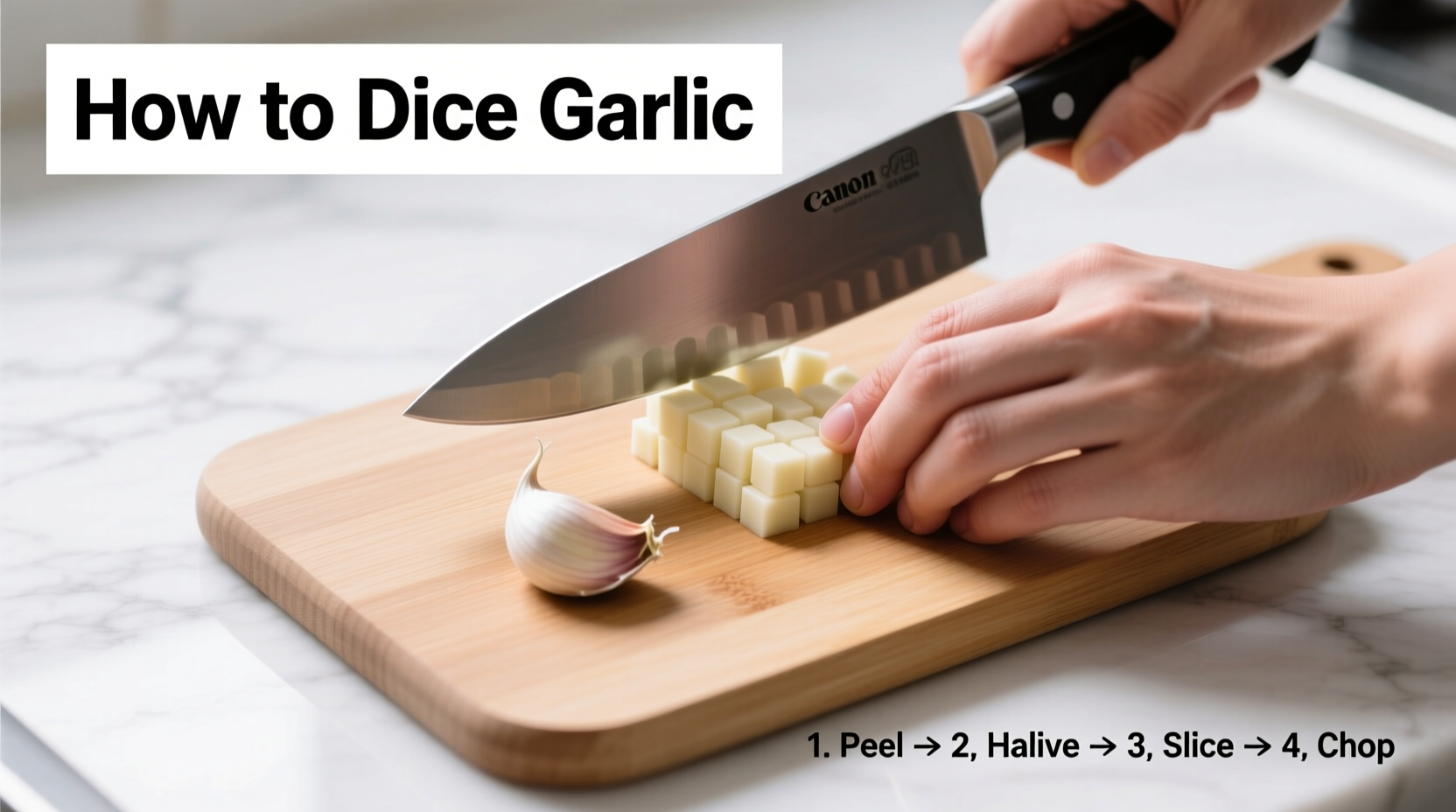Master the perfect garlic dice in just 5 minutes with this professional chef-tested method: First, peel the clove by smashing it lightly with your knife. Remove the papery skin, trim the root end, and slice vertically into thin planks. Rotate 90 degrees, then make parallel cuts for even cubes. This technique yields uniform 1/8-inch pieces that cook evenly and release optimal flavor without burning.
Garlic transforms ordinary dishes into extraordinary culinary experiences—but only when prepared correctly. As a chef who's worked in Michelin-starred kitchens and taught thousands of home cooks, I've seen how improper garlic dicing ruins meals more often than you'd think. Burnt garlic turns bitter, uneven pieces create flavor inconsistencies, and rushed preparation misses out on garlic's full aromatic potential.
Why Garlic Dicing Technique Matters
Garlic's flavor compounds activate when cells are ruptured. The size of your dice directly impacts how these compounds interact with heat and other ingredients. According to food science research from the USDA Agricultural Research Service, smaller garlic pieces release more allicin (the compound responsible for garlic's characteristic flavor) but burn faster. Professional chefs maintain precise control over this chemical reaction through consistent dicing.
| Preparation Method | Surface Area | Flavor Release | Best For |
|---|---|---|---|
| Whole Clove | Low | Mild, subtle | Roasting, infusing oils |
| Sliced | Moderate | Balanced flavor | Sautéing, stir-fries |
| Diced (1/8") | High | Intense, immediate | Sauces, dressings, quick-cooking dishes |
| Minced | Very High | Maximum potency | Raw applications, marinades |
Your Essential Garlic Dicing Toolkit
You don't need specialized equipment—just three basic kitchen items:
- A sharp chef's knife (8-10 inch preferred)
- Cutting board (wood or composite material)
- Small bowl for collecting diced garlic
Professional tip: Keep your knife blade sharp. Dull knives crush garlic cells rather than cleanly cutting them, releasing bitter compounds prematurely. The Culinary Institute of America's knife skills curriculum emphasizes that proper blade maintenance is 50% of successful vegetable preparation.
Step-by-Step: Perfect Garlic Dice Every Time
Step 1: Prepare the Clove
Separate a single clove from the bulb. Place your knife blade flat on the clove and press down firmly with the palm of your hand until you hear a soft crack. This loosens the skin without damaging the garlic flesh. Remove the papery skin and trim off the root end.
Step 2: Create Stable Slices
Place the peeled clove flat-side down on your cutting board. Using a rocking motion with your chef's knife, slice vertically through the clove to create thin, even planks (about 1/8 inch thick). Keep your non-knife hand in the "claw grip" position for safety and precision.

Step 3: Form Uniform Planks
Gather your slices together and rotate them 90 degrees. Make parallel cuts across the slices at 1/8-inch intervals. For consistent results, professional chefs recommend using the tip of your knife as a guide—your knuckles should gently rest against the blade for controlled movement.
Step 4: Final Dice
Rotate the garlic 90 degrees once more and make final perpendicular cuts through the planks. You should now have perfectly uniform cubes. Transfer immediately to your cooking vessel—diced garlic begins oxidizing within minutes, which can affect flavor.
Avoid These Common Garlic Dicing Mistakes
Even experienced home cooks make these critical errors that compromise flavor:
Mistake 1: Skipping the Smash Step
Trying to peel garlic without smashing first wastes time and damages the clove. The gentle pressure from smashing separates the skin from the flesh without crushing the garlic cells that contain bitter compounds.
Mistake 2: Inconsistent Sizing
Uneven pieces cook at different rates—some burn while others remain raw. Maintain consistent 1/8-inch measurements for even cooking. As noted in Harold McGee's On Food and Cooking, garlic's flavor compounds react differently to heat based on particle size.
Mistake 3: Overcrowding the Pan
Adding too much diced garlic to hot oil at once lowers the temperature, causing steaming instead of sautéing. Professional kitchens add garlic in batches when preparing large quantities to maintain optimal cooking temperature.
When to Choose Alternative Methods
While precise dicing works for most applications, certain dishes benefit from different preparations:
- For slow-cooked dishes: Leave cloves whole to prevent bitterness from prolonged cooking
- For raw applications (like aioli): Mince extremely fine or use a mortar and pestle for smooth texture
- When time-pressed: Use a garlic press for sauces where texture doesn't matter
Important context boundary: Never use pre-minced garlic from jars for high-heat cooking. The USDA Food Safety and Inspection Service warns that commercially prepared minced garlic often contains preservatives that create off-flavors when heated.
Storing Diced Garlic Properly
Diced garlic oxidizes quickly, losing flavor and developing bitterness. For best results:
- Use immediately for maximum flavor impact
- If storing is necessary, place in an airtight container with a light coating of olive oil
- Refrigerate for no more than 24 hours (per FDA food safety guidelines)
- Never store at room temperature—this creates botulism risk
Professional kitchens never pre-dice garlic for later use. The flavor degradation begins within minutes of cutting, as documented in research published by the Journal of Agricultural and Food Chemistry.
Putting It All Together: Your Garlic Dicing Checklist
Before you start cooking, verify you've completed these critical steps:
- Garlic cloves properly peeled using the smash method
- Knife blade sharpened and clean
- Cutting board stabilized with damp towel
- Consistent 1/8-inch measurements maintained
- Diced garlic transferred immediately to cooking vessel
Mastering this technique transforms your cooking—properly diced garlic distributes flavor evenly throughout dishes without burning. You'll notice immediate improvements in sauces, stir-fries, and roasted vegetables. Remember: in professional kitchens, we say "garlic should perfume the dish, not dominate it"—and precise dicing is how you achieve that perfect balance.
Frequently Asked Questions
How small should garlic be diced for most recipes?
For most applications, aim for 1/8-inch cubes. This size provides optimal flavor release without burning. Larger dices (1/4-inch) work for slow-cooked dishes, while finer dices (1/16-inch) are best for raw applications like dressings where immediate flavor impact is desired.
Can I use a food processor to dice garlic?
While possible, food processors often create uneven, pulpy garlic that burns easily. The blades generate heat that prematurely activates garlic's enzymes, creating bitter flavors. For authentic restaurant-quality results, hand dicing with a sharp knife produces superior texture and flavor control.
Why does my diced garlic always burn in the pan?
Garlic burns because of three common issues: oil temperature too high (keep at medium-low), uneven dice size (smaller pieces burn first), or overcrowding the pan. Professional chefs add garlic to already-warmed oil (not cold oil), maintain consistent 1/8-inch pieces, and never leave it unattended during the 30-60 second cooking window.
How can I prevent my hands from smelling like garlic after dicing?
Rub your hands with stainless steel (like your sink faucet) under cold water immediately after handling garlic. The sulfur compounds in garlic bind to the steel instead of your skin. Alternatively, use lemon juice or vinegar on a cloth to wipe your hands. Professional chefs keep a stainless steel "garlic bar" specifically for this purpose.
Is there a difference between dicing and mincing garlic?
Yes—dicing creates uniform cubes (typically 1/8-inch), while mincing produces much finer particles (1/16-inch or smaller). Diced garlic provides even flavor distribution in cooked dishes, while minced garlic releases maximum flavor immediately, making it better for raw applications like dressings or marinades where intense garlic flavor is desired.











 浙公网安备
33010002000092号
浙公网安备
33010002000092号 浙B2-20120091-4
浙B2-20120091-4